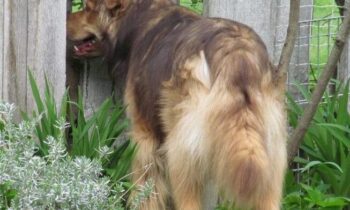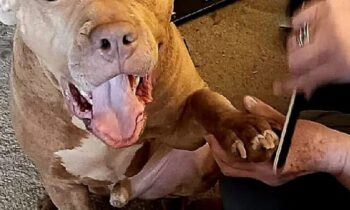
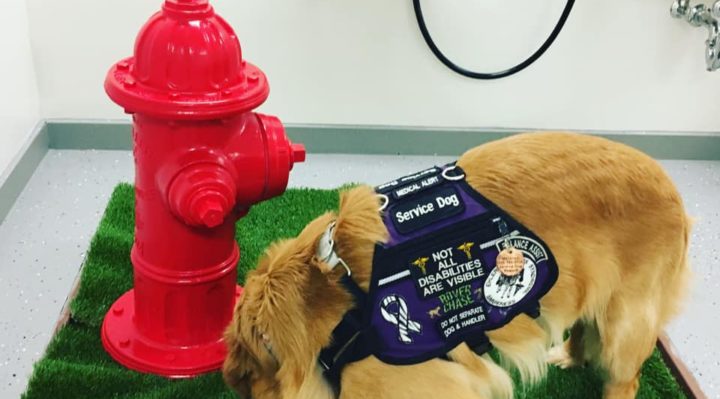
Years ago, my golden retriever, by then older than the age to which many of his breed live, was diagnosed with failing kidneys. There was no cure, no surgery—his kidneys were worn out. There was nothing to be done except our own version of hospice care right here at home: Keep him comfortable and happy for as long as possible. He was fifteen when he passed. He had been treasured all the minutes of his life, even more so in those last months.
At first, after the diagnosis, an incipient crisis: he would not eat, and nutrition was at the top of his needs list. I was demoralized.
I asked my vet for advice. He had been, at that time, my veterinarian for over 30 years. By the time he retired, it was 40-plus years, all the vet care for my family. He was an important person in my life.
The advice was simple, to the point, so perfect:
“To get him to eat, you’ve got to get him to eat.”
We’d discussed many options in addition to the prescription food, kibble and canned, best for kidneys, so I had a short list of foods that would be safe for him to eat and possibly enticing. (The dog had always been an enthusiastic eater. He was a golden, after all!)
My veterinarian was right.
I turned my dog-guardian powers on to experiment with foods that might interest my dog.
He was interested! He ate some small bites.
He went back for more! He was eating!
The canned prescription diet turned out to be a more-than-palatable meal to my dog after I made a big deal of serving it “by hand” to him, bite by bite. He ate every serving!
“To get him to eat, you’ve got to get him to eat.”
I think of that motto often. It applies so well to many behaviors we want our dogs to perform … to do, as opposed to not to do. Eating and elimination may be at the top of that list.
This winter, where I live, we went through too many below-zero days and nights. On social media, I saw a growing number of posts bemoaning the need to walk the dog in those arctic temperatures. It had to be done because the dog in question eliminates only on walks away from home.
Brrr!
What if a dog could learn to “do his duty” inside for situations in which indoor elimination would be the best, safest option? Too cold, too hot; too smoky, too skunky? Here’s how it works.
“To get a dog to use potty pads inside, you’ve got to get him to use potty pads inside!”
I asked dog professionals online for their tips for dog guardians. I added that I was looking for simple instructions for beginners:
“How to retrain a dog accustomed to “going” outside (on walks or in a fenced area) to using potty pads inside—a skill to be used the next time it’s too cold or too hot for a dog to “go” outside safely?”
Marilyn Marks (Connecticut) This is a job of teaching the dog that a new surface is also a bathroom just like the grass they’re used to. It’s like if you go to a foreign county, as I did, and there is a shelf of porcelain a few inches below instead of the basin you’re used to. It’s not easy to let go because it’s just not “right.” The dog may feel the same about the potty pad—it doesn’t feel, look, or smell like grass, so it doesn’t trigger a response to go there. What you need to do is re-housebreak them to their new potty spot—a pad. Get them to that spot when they need to go, supervise or confine so they don’t “go” anywhere else, praise and reward for going on the pad. Some dogs will easily make the switch and others won’t.
Laura Bourhenne (California) Does it have to be pads? Because honestly, I would use a litter box and alfalfa or other hay pellets. At least they smell somewhat like what dogs are used to outside. They would just go into the trash as pee pads would. And they are more environmentally safe.
Harve Morgan (California) The few times that I had to use the pads for dogs after surgery or whatever, I didn’t have to do training. They just went on it. I think those pads have a built-in scent. The biggest problem I’ve had is them hitting it. I get the biggest pads I can find even for the small dogs. Now I have seen them used with cats too. Cats with a medical problem and the cat doesn’t want to use the litter box. Cats that have been declawed might prefer the pads too.
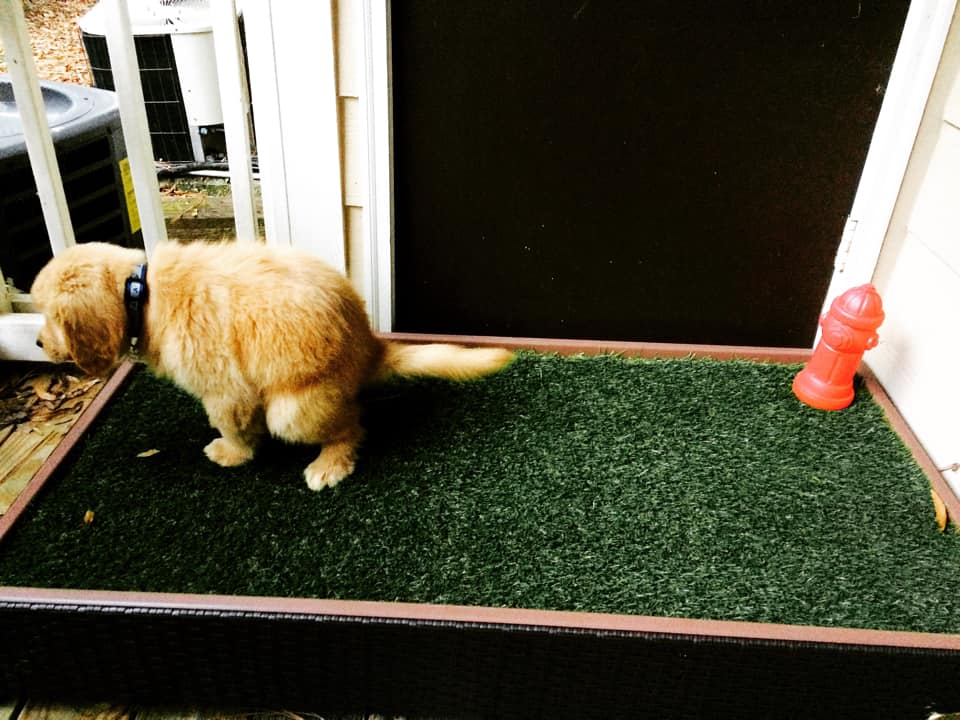
Photo by Abigail Witthauer
Abigail Witthauer (Alabama) When I got Macallan, I lived in a one-bedroom apartment by myself in the Deep South and I didn’t want to have to potty-train a puppy in the rain/heat/ice that was the reality of a late-summer puppy. I also knew I wanted him to have a lot of potty flexibility as a service dog. This is what we did with him and have done with several others for various reasons. The baby puppy picture is on my apartment balcony when he first came home. That potty spot is “porch potty” brand and it was AWESOME for that purpose.
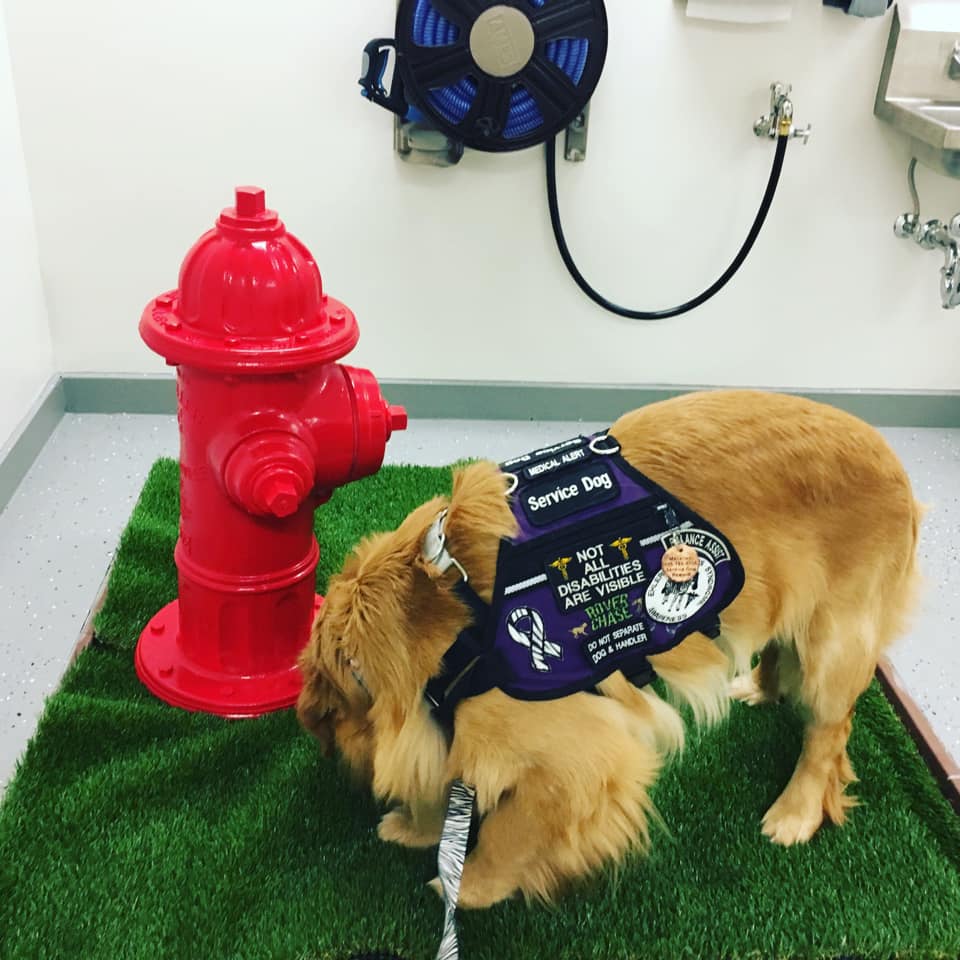
Photo by Abigail Witthauer
Here are my brief tips:
1. Consider a live turf service. There are several available that ship a square (sized for your dog) of live grass in a litter box on a regular schedule
2. Create an exercise pen around the area you would like to be the “potty spot.” Place the substrate desired (potty pads/turf/litter) over the ENTIRE xpen area. Gradually remove one “square” every several days of successful peeing on the larger area, until you are left with just one pad/litter box/turf. Then gradually increase the xpen size until the dog is regularly targeting the one assigned potty spot with each enlargement—then remove the xpen.
3. Consider whether you could put the desired potty spot outside, but in a more enclosed area like a carport/garage/balcony.
All three photos are of Macallan at various ages and various locations. Macallan is a The Roverchase Foundation service dog and owned by me.
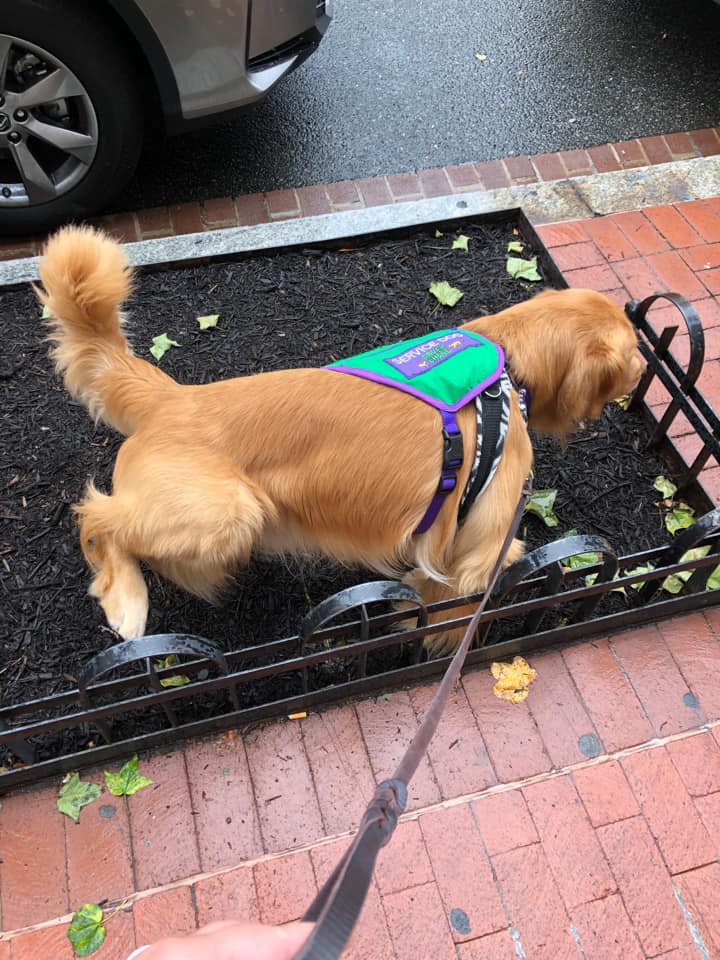
Photo by Abigail Witthauer
The substrate can vary—it doesn’t have to be potty pads; that’s up to you. Potty pads are easy to get, to transport, to dispose of. But don’t use only potty pads. As you can, add to your dog’s list of familiar and accepted (by the dog) “potty spots.” Use the most convenient set-up on a case-by-case basis, depending on the current situation. For you and for your dog, flexibility is the goal.
The reward for the dog is the relief he feels when he’s eliminated. Additional rewards could be verbal praise, treats, preferred play, etc.
As you train, you’ll find out what works best for you and for your dog.


